Customer Value Optimization: How to Build an Unstoppable Business
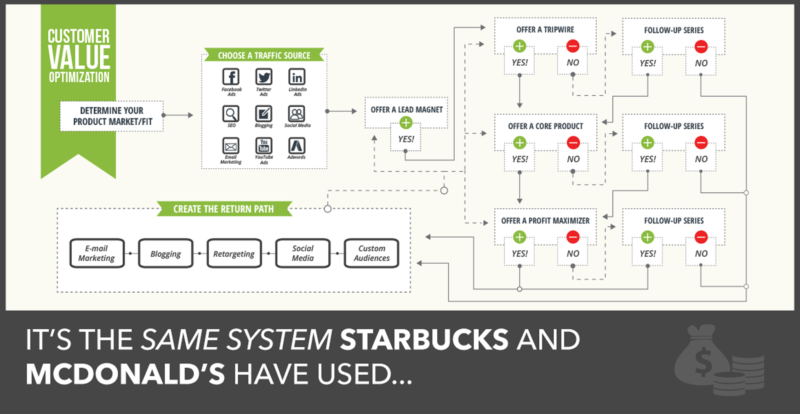 [/imageframe][/one_full][one_fifth last=”no” spacing=”yes” center_content=”no” hide_on_mobile=”no” background_color=”” background_image=”” background_repeat=”no-repeat” background_position=”left top” hover_type=”none” link=”” border_position=”all” border_size=”0px” border_color=”” border_style=”” padding=”” margin_top=”” margin_bottom=”” animation_type=”” animation_direction=”” animation_speed=”0.1″ animation_offset=”” class=”” id=””][/one_fifth][three_fifth last=”no” spacing=”yes” center_content=”no” hide_on_mobile=”no” background_color=”” background_image=”” background_repeat=”no-repeat” background_position=”left top” hover_type=”none” link=”” border_position=”all” border_size=”0px” border_color=”” border_style=”” padding=”” margin_top=”” margin_bottom=”” animation_type=”” animation_direction=”” animation_speed=”0.1″ animation_offset=”” class=”” id=””]
[/imageframe][/one_full][one_fifth last=”no” spacing=”yes” center_content=”no” hide_on_mobile=”no” background_color=”” background_image=”” background_repeat=”no-repeat” background_position=”left top” hover_type=”none” link=”” border_position=”all” border_size=”0px” border_color=”” border_style=”” padding=”” margin_top=”” margin_bottom=”” animation_type=”” animation_direction=”” animation_speed=”0.1″ animation_offset=”” class=”” id=””][/one_fifth][three_fifth last=”no” spacing=”yes” center_content=”no” hide_on_mobile=”no” background_color=”” background_image=”” background_repeat=”no-repeat” background_position=”left top” hover_type=”none” link=”” border_position=”all” border_size=”0px” border_color=”” border_style=”” padding=”” margin_top=”” margin_bottom=”” animation_type=”” animation_direction=”” animation_speed=”0.1″ animation_offset=”” class=”” id=””]You’ve finally found it…
This resource is designed for those unfamiliar with Internet Marketing (IM)— and for those salty IM veterans that want a refresher course on the basic principles of internet marketing.
It’s also a road map of sorts.
You see — all marketers and entrepreneurs are at various levels of STUCK. There’s just so much to learn.
From beginner to seasoned pro — we are all looking to get better at what we do — always looking for an edge. It’s our defining characteristic.
This page is here to help you master this internet marketing stuff.
And by “stuff” we mean…
The System
It’s the same system Starbucks and McDonald’s have used to corner the coffee and hamburger markets. It’s the same system Amazon uses to dominate e-commerce. It’s how Best Buy, Beach Body (selling workouts like P90X) and Sports Illustrated have become household names.
This system works for small and enterprise level businesses. It works for mom-and-pop shops and billion dollar retailers. It works whether you sell traditional products, digital products or services.
This system works because it exploits each and every aspect of the irrefutable law of business growth put forth by legendary marketer Jay Abraham:
There are only three ways to grow a business,
- Increase the number of customers
- Increase the average transaction value per customer
- Increase the number of transactions per customer
We call it Customer Value Optimization or CVO.
Read this page carefully. Read it multiple times and commit it to memory.
This is the stuff they don’t teach in business school.
Learn the Steps to Customer Value Optimization
The following flowchart outlines the CVO system.
When you’re learning new tactics like Facebook Advertising, Google Analytics or SEO you’ll need to constantly remind yourself of the CVO process. Otherwise, you’re wasting time and money.
This is a warning: There is little profit in understanding, for example, Pinterest advertising or Search Engine Optimization (SEO) in and of itself. There is enormous profit in understanding how to apply these traffic strategies to the CVO process.
Here is a flowchart of the Customer Value Optimization system…
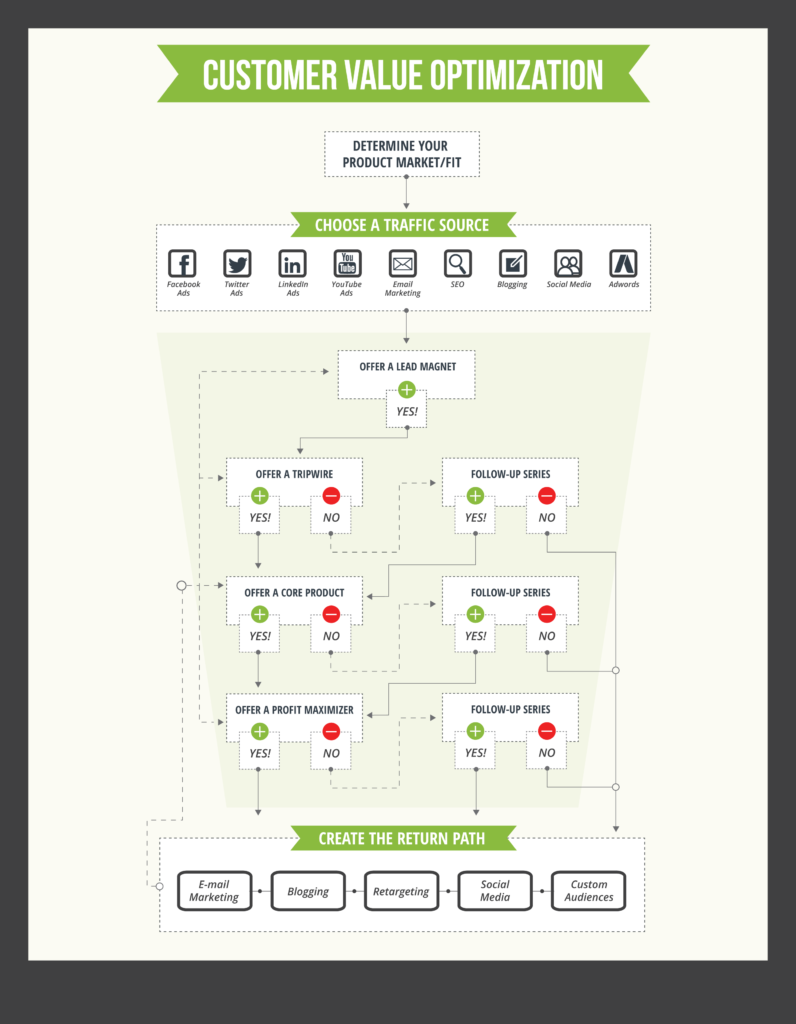
Here are the steps,
- Determine Product/Market Fit
- Choose a Traffic Source
- Offer a Lead Magnet
- Offer a Tripwire
- Offer a Core Product
- Offer a Profit Maximizer
- Create the Return Path
Lean in to this article and pay close attention — we’re about to reveal the exact process we use to sell products and services in multiple niche markets and mainstream verticals including…
- Finance and Investing
- Men’s Clothing
- Home Improvement
- Survival and Preparedness
- Beauty
… just to name a few.
Let’s begin with…
Step 1 – Determine Product/Market Fit
Business is pretty simple.
We get paid to move people from a “Before” state to a desired “After” state.
In the “Before” state the customer is discontent in some way. They might be in pain, bored, frightened or unhappy for any number of other reasons.
In the “After” state — life is better. They are free of pain, entertained or unafraid of what previously plagued them.
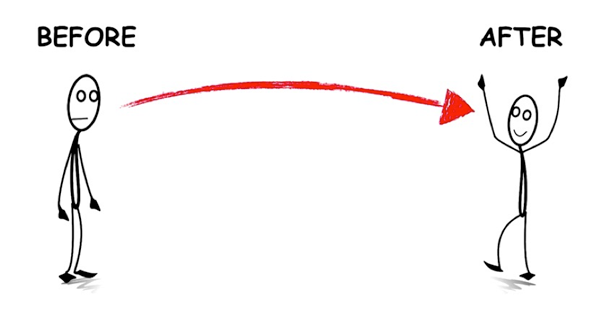
People don’t buy products or services…
They buy outcomes. They buy access to the “After” state.
A great offer will genuinely move a customer to a desired “After” state…
… and great marketing simply articulates the move from the “Before” state to the desired “After” state.
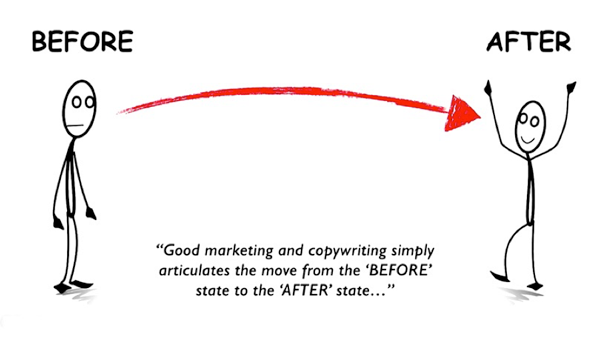
Most businesses that fail, particularly at start-up or when entering new markets, do so because either…
- They fail to offer a desired “After” state (The offer is no good)
- They fail to articulate the movement from “Before” to “After” (the marketing is no good)
Needless to say — getting clear on the desired outcome your offer delivers is fundamental to the success of your business.
Here’s how to get that clarity…
The 8-Question “Before/After” Grid
Before you create or market another offer — go through this exercise.
Ask yourself these 8 questions…
- What does your prospect HAVE in the “Before” state? What does your prospect HAVE in the “After” state?
- How does your prospect FEEL in the “Before” state? How does your prospect FEEL in the “After” state?
- What is an AVERAGE DAY like for your prospect in the “Before” state? What is an AVERAGE DAY like for your prospect in the “After” state?
- What is your prospect’s STATUS in the “Before” state? What is your prospect’s STATUS in the “After” state?
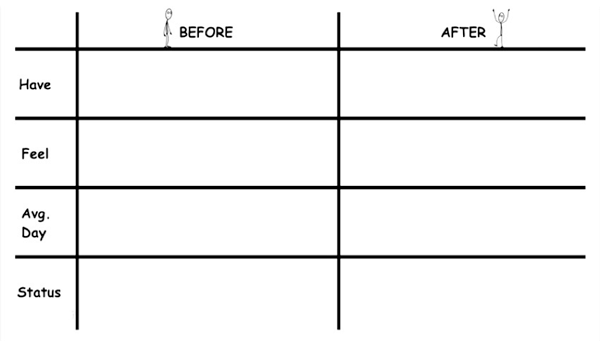
For example, we’ve done some consulting for a company that offers a product to parents of babies.
It’s a little, squishy baby bath tub you place in a sink or in a larger bathtub. It keeps the baby comfortable and safe while the parent bathes them.
But it does so much more than that.
As a father of four, I know that bath time for baby is a scary, frustrating experience.
Customers that buy this soft, safe baby bathtub are transformed…
- From HAVING a cold, hard bathtub to a warm, squishy bathtub.
- From FEELING scared and frustrated to confident and in control at bath time.
- From having an AVERAGE DAY with a terrible bath time experience to making bath time a breeze.
- From a STATUS of unappreciated as a mother to a “super mom.”
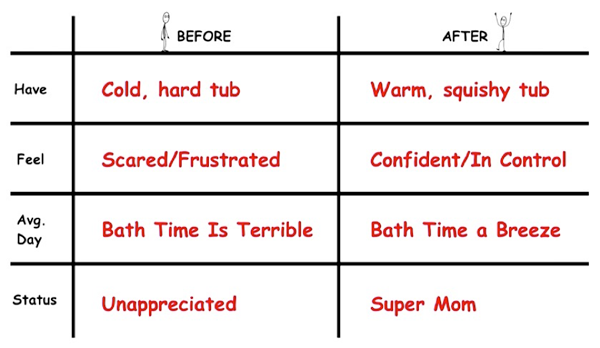
Average marketers only articulate what a customer will HAVE if they purchase their product or service. Great marketers speak to how a customer will FEEL, how their AVERAGE DAY will change and how their STATUS will elevate.
With this simple 8-Question “Before/After” Grid, any half decent copywriter will be able to create a marketing message that will have an impact.
The marketing copy writes itself now that you are clear on the “Before” and “After”…
- “Bath time with your newborn doesn’t have to be a scary, frustrating experience.”
- “Say goodbye to bath time stress. You’ll actually enjoy bathing baby with this safe, comfortable bath tub.”
- “You’ll feel like Mother of the Year as your baby plays and bathes in the safety of this warm, soft bath tub.”
Do you see how this copy clearly articulates how the product will move mom from a “Before” state of stress and unhappiness to to an “After” state of joy and happiness with baby?
It’s powerful stuff.
But understanding how you will transform your prospect from a “Before” state to a desired “After” state also impacts…
How much you can charge
What is the distance between the “Before” and desired “After” state?
That distance is called VALUE.
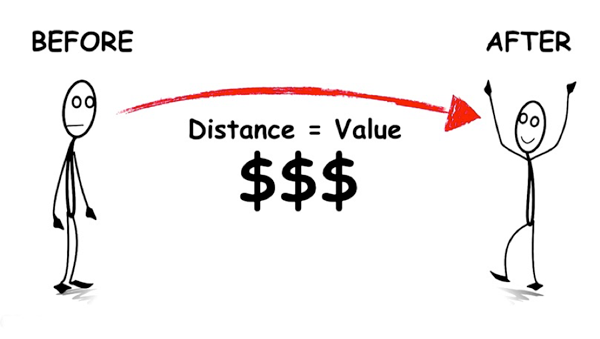
Want to charge more for your products and services?
Simple — create a greater distance between the “Before” and desired “After” state by either:
- Creating a better product or service (better offer)
- Articulating the movement from “Before” to “After” differently or more clearly (better marketing.)
When rolling out a new offer, starting a new company or moving into a new market — keep it simple.
Get clear on your “Before” and “After.”
If you’re not able to clearly articulate how you can take your prospect from the “Before” state to a desired “After” state — you may have an issue with Product/Market Fit.
There may be nothing more important than Product/Market Fit, simply because every other part of the process is dependent upon having a group of willing and able buyers.
In the next step, we’ll dispel the myth behind traffic generation…
Step 2 – Choose a Traffic Source
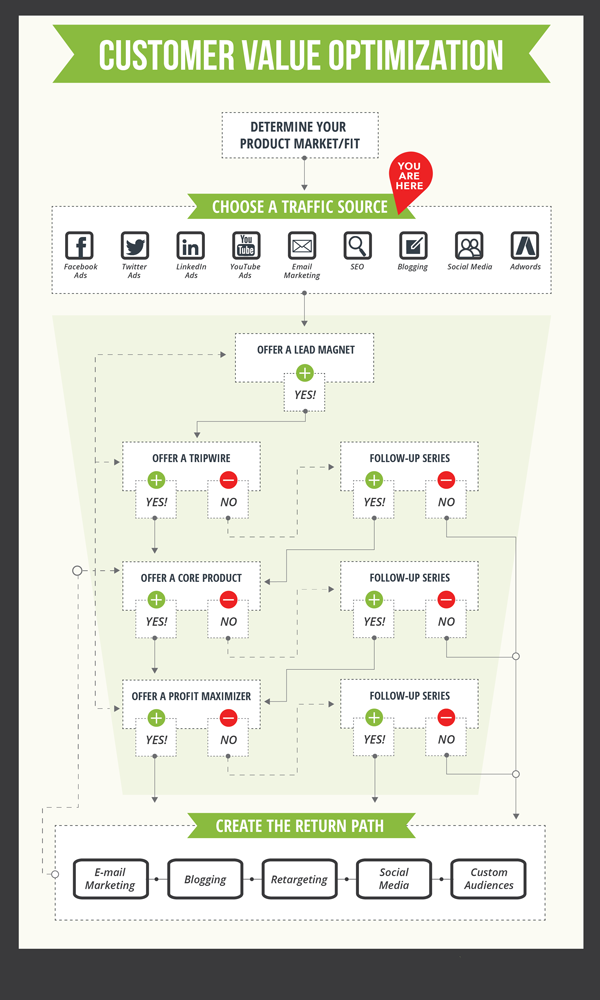
This might shock you but you DO NOT have a traffic problem.
You might have a business model problem, an offer problem or a measurement problem.
But you DO NOT have a traffic problem.
Here’s why…
What if I told you that every time you get a visitor to a web page you make $10 in profit? Could you get traffic to that web page?
Heck yes you could. You could pay up to $10 to get a visitor to that web page and still break even. In fact, you’ll be able to pay more than $10 to get a visitor to that page when you truly understand the whole of Customer Value Optimization.
I’ve often said,
“He who can spend the most money to acquire a customer, wins.”
And Jeff Bezos, Founder and CEO of Amazon.com, once said (in a tongue-and-cheek warning to his competitors)…
“Your margin is my opportunity.”
The lesson we’ve learned is that once you understand CVO, you become unstoppable. Amazon.com sells on the thinnest of margins knowing that acquiring new customers, selling them more and selling to them more frequently is how you become unstoppable.
Traffic is not a problem.
Google, Facebook, Pinterest, Twitter and LinkedIn, just to point out the obvious, are lining up to sell you targeted traffic. Your Search Engine Optimization agency wants to send you more traffic. Your Pay-Per-Click agency would love nothing more than to send you more clicks.
You simply need to understand,
- How to measure what traffic is worth
- How to extract maximum immediate value from that traffic
Tactics are worthless if you don’t understand the CVO process.
This is why you are frustrated. You have no context. You have no system.
We can teach you to drive traffic through tactics like blogging, Facebook Ads or email marketing but first you need to understand the system.
The goal, no matter which traffic source you choose, is to drive prospects into the CVO Funnel.
Become a master of a single, steady traffic source. Stay focused on that traffic source and, once mastered, add a second and third traffic source.
These traffic sources include…
- Email marketing
- Social Advertising (Facebook/Twitter/YouTube ads, etc)
- Banner Advertising
- Blogging
- Organic Social Media
- SEO
Your traffic strategy (if the goal is acquiring new leads and customers) begins and ends with driving visitors into the CVO funnel.
It begins with the Lead Magnet…
Step 3 – Offer a Lead Magnet
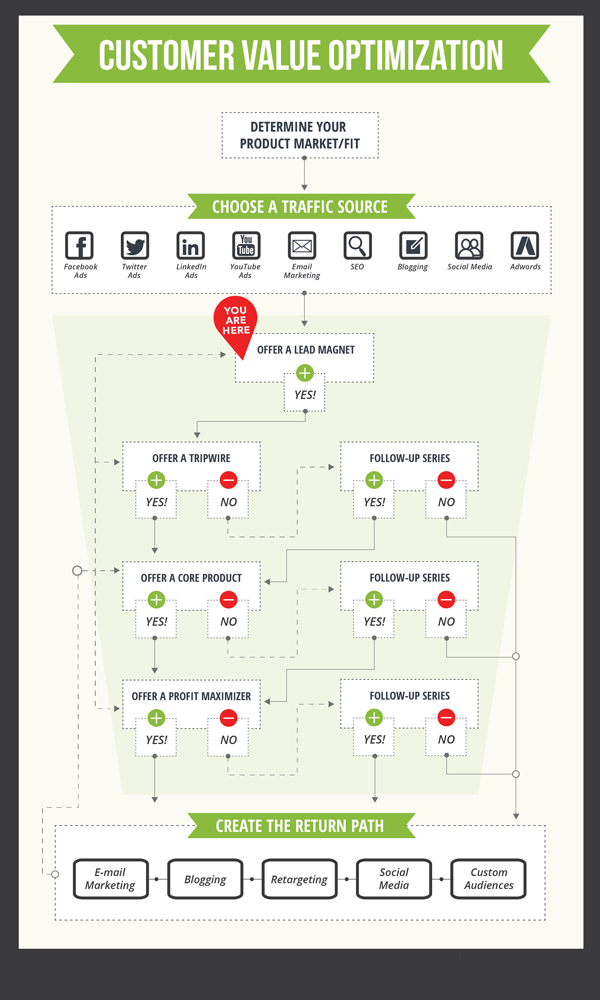
The next two sections (Offer a Lead Magnet and Offer a Tripwire) show you how to grow your business through the first of Jay Abraham’s methods, increase the number of customers.
The Lead Magnet is an irresistible bribe that gives a specific chunk of value to a prospect in exchange for their contact information.
Make no mistake, although no money changes hands, this is a transaction. And, it is often the first transaction you will have with a prospect.
You will need to provide tremendous value with the Lead Magnet.
The Lead Magnet is usually offered on a web page called a landing or squeeze page that is optimized to convert even cold traffic into leads.
The Lead Magnet exists to increase leads. Because the Lead Magnet is the very top of the CVO Funnel, increasing opt-ins here will pay dividends throughout the rest of the system.
But all Lead Magnets are not created equal. The best will convert north of 50% of visitors into leads and you’ll be relieved when I tell you that the highest performing Lead Magnets have one thing in common..
Specificity: The Key to Getting More Leads
What irresistible bribe could you offer in exchange for a prospect’s contact information?
The good news is that you DO NOT need to create something lengthy or complex. In fact, we’ve found that the more laser-focused your Lead Magnet is — the better it will convert.
So, for example, this is NOT a good Lead Magnet…

There is no offer in this Lead Magnet, much less a specific one.
But this Lead Magnet isn’t much better. There is an offer but it isn’t specific…
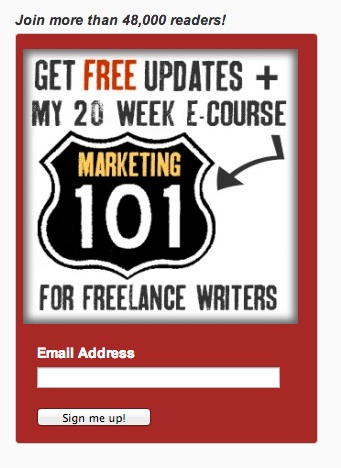
Your prospect doesn’t want a 20-Week E-Course. They want to solve a problem. They want an outcome.
Contrast the prior two Lead Magnets with the specific problem that is addressed in this Lead Magnet…
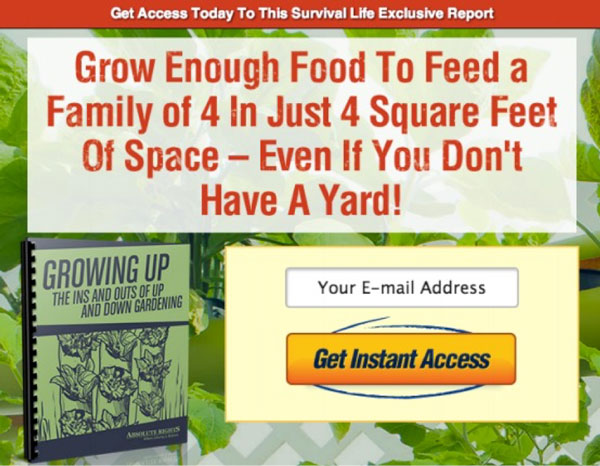
A Lead Magnet that solves a specific problem for a specific segment of the market will generate more leads…
… and more leads means more Tripwire sales.
Step 4 – Offer a Tripwire
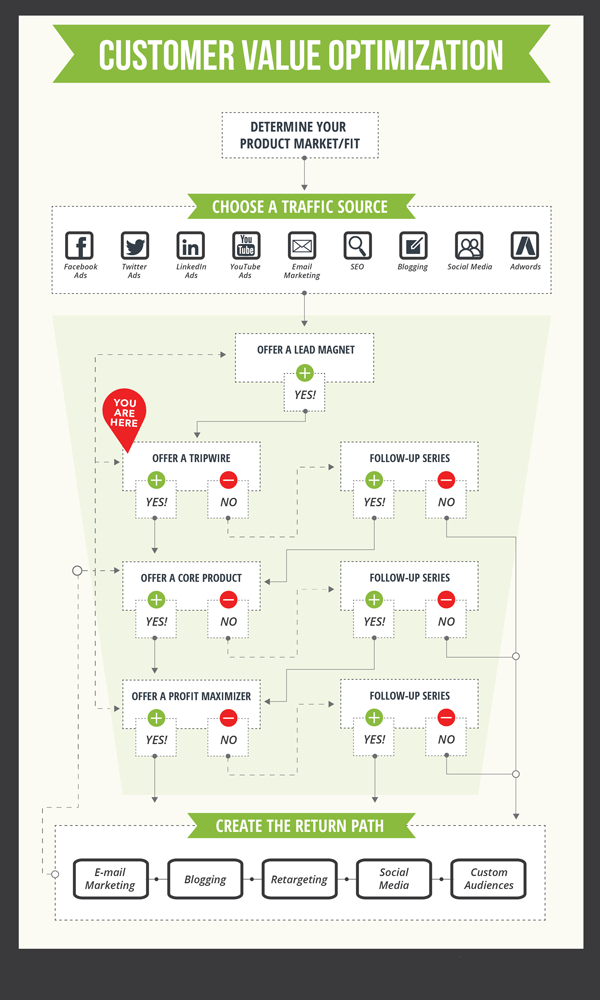
If you understand and execute on this step, you’ll be ahead of most of your competitors.
Remember, our first goal is to increase the number of customers. So far, we have only generated leads through the Lead Magnet. We still haven’t generated new customers.
The Tripwire offer is made to those that have displayed interest through the Lead Magnet.
The Tripwire is an irresistible, super low-ticket offer (usually between $1 and $20 that exists for one reason and one reason only… to convert prospects into buyers. In markets selling high-ticket products and services Tripwire offers as high as $500 can convert well.
The goal of the Tripwire is to fundamentally change the relationship from prospect to customer. The conversion of a prospect to a customer, even for $1, is magical.
The key is to make a Tripwire Offer that leads are unable to resist.
The most common way to make the Tripwire irresistible is by selling it at cost and, in some cases, at a loss to you.
That’s correct — you are not trying to make a living from selling Tripwire Offers. You are trying to acquire buyers because there is nothing more valuable than a list of buyers.
When you understand the rest of the Customer Value Optimization process you will understand how the Tripwire Offer is the single most powerful addition you can make to your business — even though you make no direct profit from it.
A classic example of a Tripwire Offer comes from Columbia Records,
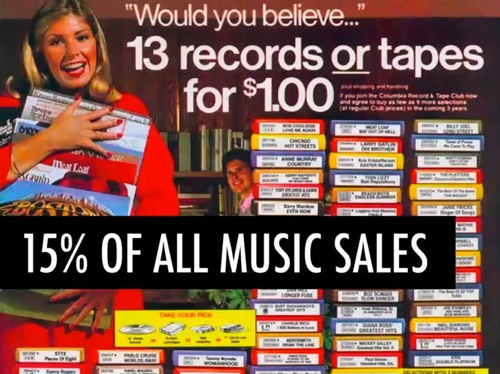
Columbia House took over the music market by making an absolutely irresistible offer (13 records or tapes for $1) because they understood that acquiring a list of buyers is the name of the game.
Types of Tripwire Offers
Physical products can make fantastic Tripwire offers…
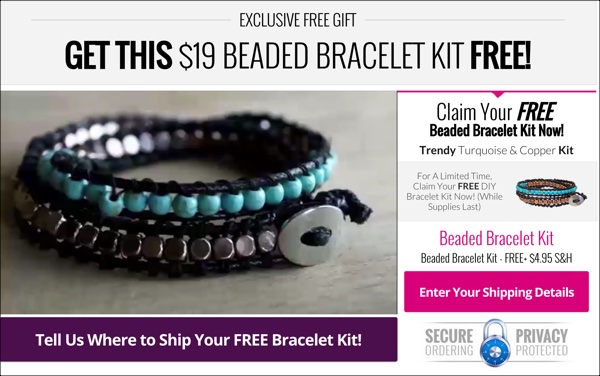
or pieces of software…
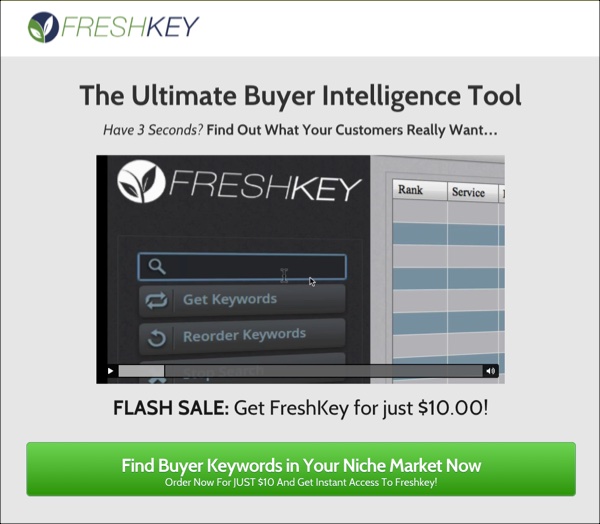
and paid webinars like Digital Marketer’s Black Friday Bootcamp…
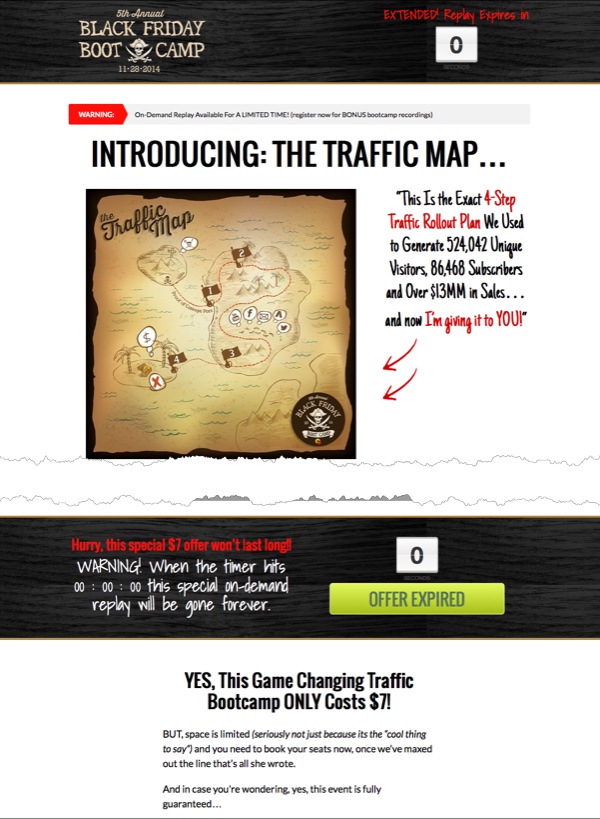
And lastly, an a la carte service like a deeply discounted teeth whitening session from a dental office or a ridiculously cheap domain registration service works wonders at acquiring customers…
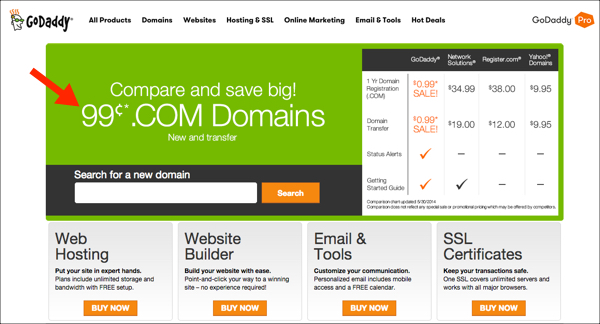
Tripwires are all around us.
It’s the ridiculous flat screen TV deal at Best Buy. It’s the rock-bottom price of a Kindle Fire. It’s the $20 for $50 worth of Mexican Food Groupon offer. It’s every service offered for $5 measly bucks on Fiverr.
The strategy behind the Tripwire is simple:
Convert the maximum number of Lead Magnet leads into paying customers, even at the expense of your profit margin, with the understanding that acquiring a paying customer will deliver profit through the next three steps:
- Core Offer
- Profit Maximizer
- Return Path
Ok, now that you understand how to increase the number of customers, let’s talk about increasing the average transaction value per customer.
Step 5 – Offer a Core Product
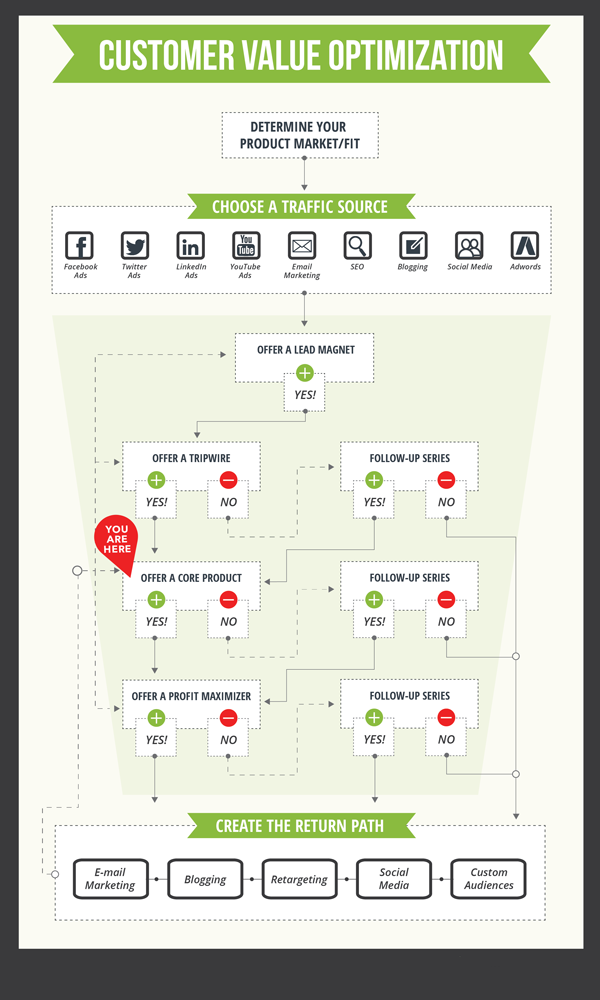
You likely already have a Core Offer. It’s your flagship product or products.
Most businesses get nowhere by making Core Offers to cold prospects. You’ll see your Core Offer sales explode with the addition of the Lead Magnet and Tripwire Offer.
After all, you’ve already had two successful transactions with this buyer.
This is why it’s critical to over deliver with the Lead Magnet and Tripwire.
In some cases, sales from the Core Offer will make you profitable. But it doesn’t have to. If you follow through on the CVO process, you could take everything you make from the Core Offer and reinvest it to acquire more customers.
Again, this is how you become unstoppable. You build a system in which you can spend more to acquire a customer than your competitors.
Your competitors are making a Core Offer and trying to make a living from it. You don’t need to make a dime from your Core Offer.
Remember, as Jeff Bezos says, your competitor’s margin is an opportunity. It is your opportunity to, for example, spend more on traffic acquisition, conversion rate optimization or increase the value of your offers.
It might stun you to find out that many of the most successful businesses in the world make no profit until they reach the next two stages, Profit Maximizers and Return Path.
Here’s where things get very interesting…
Step 6 – Offer a Profit Maximizer
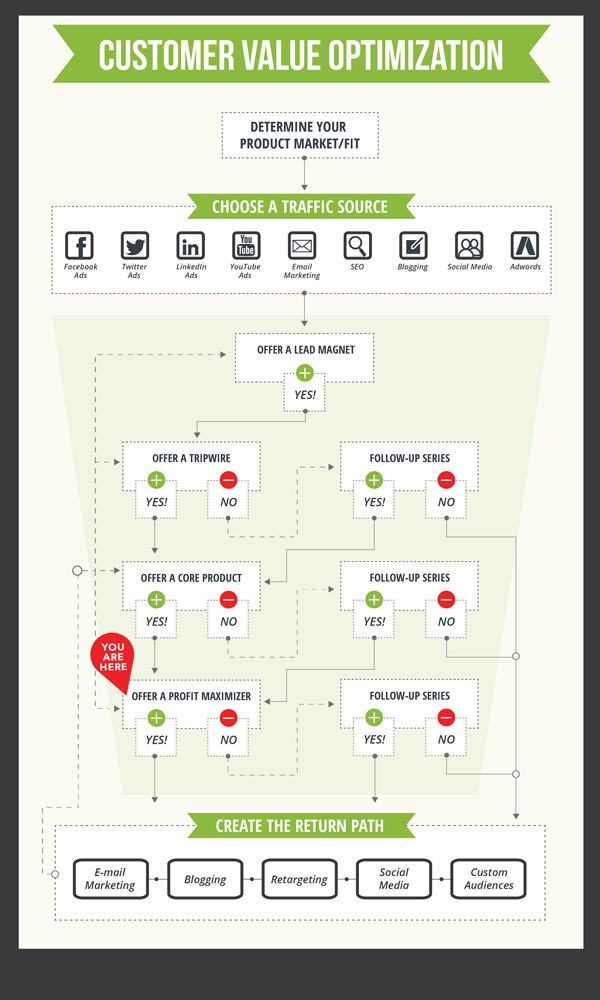
The second of Jay Abraham’s business growth methods is to increase the average transaction value per customer. The Profit Maximizer does just that.
Most businesses don’t have Tripwire Offers and they don’t have Profit Maximizers. They live and die selling cold prospects on their Core Offer.
This is why they struggle and you won’t.
Would it shock you to find out that McDonald’s makes almost no money on the hamburger. The hamburger is the Core Offer, but it’s the fry and Coke Profit Maximizer that built the Golden Arches.
This type of Profit Maximizer is called an ‘immediate upsell’…
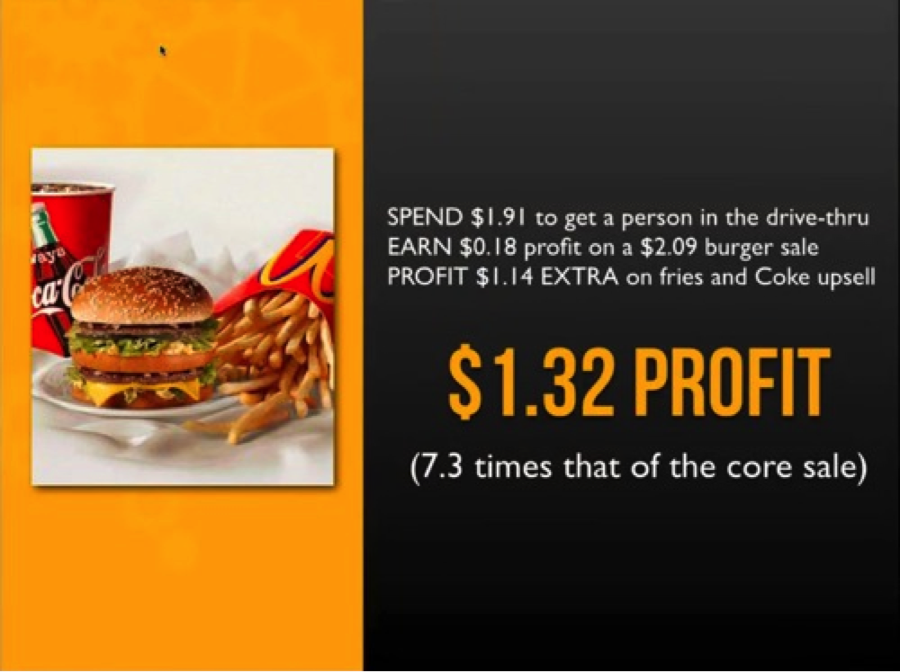
Best Buy sells laptops and plasma TV’s (Core Offers) on wafer thin margins you can’t resist and makes it up on warranties, installation and Geek Squad support (Profit Maximizers).
Amazon makes a Cross-Sell Profit Maximizer offer when they show you, “People that bought this product, also bought that product” to increase the Average Basket Value, also known as maximizing profit.
But Amazon also makes a Bundle Profit Maximizer offer with their “Frequently Bought Together” offer…
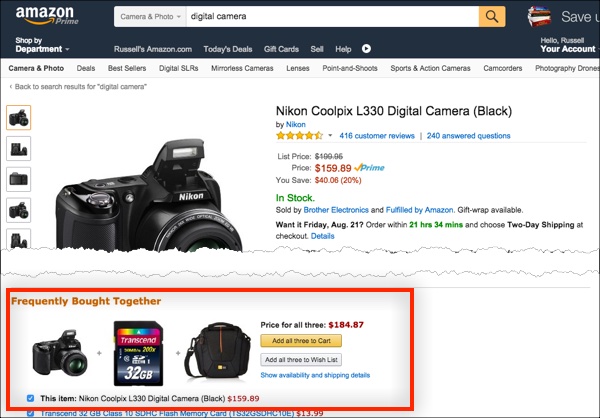
And Premium Subscriptions (recurring billing) like membership websites and other continuity offers make fantastic Profit Maximizer offers…
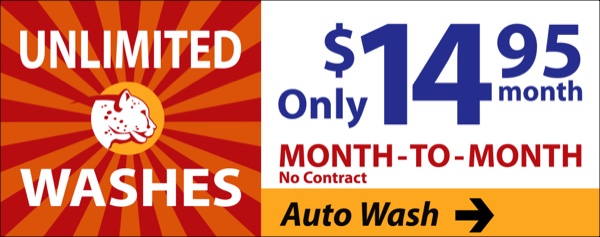
Any offer made after the initial sale is a Profit Maximizer. Because the single biggest expense most companies will incur is the cost of acquiring the customer (which is the job of the Tripwire Offer) and everything else increases the customer’s immediate and lifetime value.
What could you be offering as an upsell or cross-sell? What could you bundle with your Core Offer? How can you incorporate a subscription or membership site into your business model?
Find your Profit Maximizer and you begin to become unstoppable.
But there is one more way to grow…
Step 7 – Create the Return Path
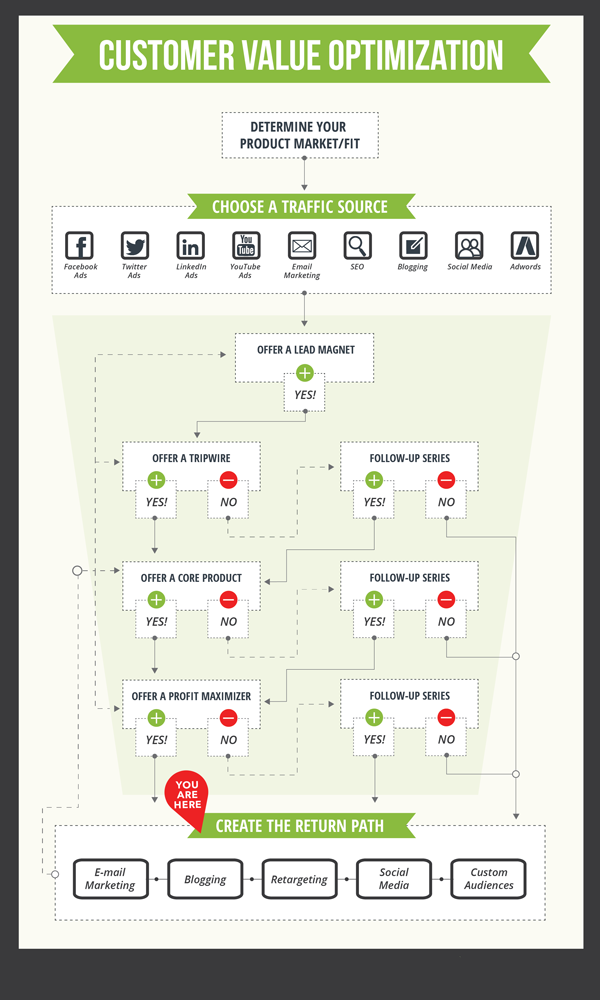
The last way to grow a business is to increase the number of transactions per customer.
Enter the Return Path.
The goal of the Return Path is to have frequent, strategic communication with your buyers and prospects that cause them to buy again and again.
Because you have received their contact information through the Lead Magnet you have the ability to continue marketing.
You can offer new Lead Magnets, Tripwires, Core Offers and Profit Maximizers because you have permission to market to them or bring them back to the Tripwire, Core Offer or Profit Maximizer that they didn’t buy the first time around.
The Return Path is anything that brings the customer or prospect back more frequently including…
- Exit Offers
- Organic Social Media (like Twitter, Facebook and LinkedIn)
- Loyalty Programs
- Content Marketing (Need Content Marketing training? Check out our Content Marketing Mastery Certification)
- Outbound Sales Calling
- Ad Retargeting (More on ad retargeting here)